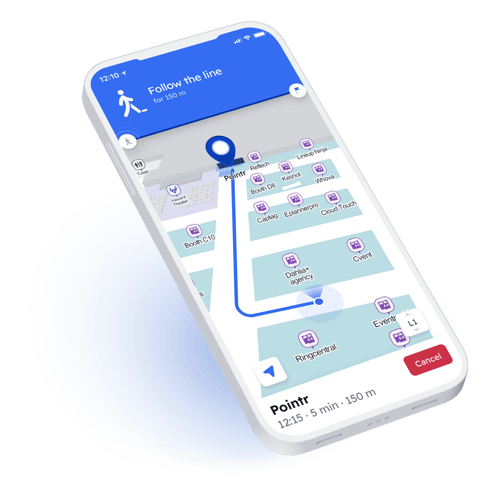Seamless Indoor Wayfinding at Scale
-
Instant wayfinding experience to any point selected on the map or through search
-
Customizable routes (such as for temporary construction) using the Pointr Cloud CMS
-
Fully functional even when mobile device is offline

Next Generation Capabilities
-
Seamless building-to-building navigation across your site’s entire campus - seamless indoor-to-outdoor wayfinding
-
Accurate multi-level detection
-
Accessibility mode to avoid stairs or always provide turn-by-turn voice directions

Success Stories
Enabling outstanding passenger experiences at Albany International Airport
- Intuitive indoor maps
- Instant, no-app access via Pointr Express®
- Wayfinding analytics
- Navigate passengers to points of interest and even back to their vehicle with Mark My Car feature
Success Stories
Powering in-app product location at The Home Depot
- The world's largest indoor mapping deployment across more than 2,000 stores
- Wayfinding integrated to product database to enable shoppers to map their lists
- Map generation and updates through AI engine
2300
Stores
350
million
Square foot
Success Stories
Enabling patient wayfinding at UCHealth
- Helping patients and visitors find their way to appointments, reducing anxiety and missed appointments
- Full integration with EpicMyChart for a smooth patient journey
- Branded maps

60
Floors
12
Buildings
The Top Choice for the Fortune 100
Chosen by Fortune 100 companies for our unmatched
precision and innovation in indoor mapping, covering
7 billion square feet in more than 5,000 venues across 35 countries.
7 billion
Square feet of space mapped
5,000+
Venues
35+
Countries

Indoor Wayfinding for Every Industry
Airports & Travel Hubs
Make your visitors’ journey seamless, from the moment they enter the car park to their departure.
Learn more
Retail
Create personalized journeys for shoppers by enabling them to search and navigate to any in-store product.
Learn more
Smart Workplace
Enable employees and visitors to navigate your corporate campus, search for meeting rooms and share their real-time location with colleagues for better collaboration.
Learn more
Hospitality
Deliver the ultimate experience for your guests by ensuring they navigate your location and search for key points of interest with the utmost ease.
Learn more
Resource center
Interview
Pointr & Okeenea Interview
See how Pointr and Okeenea are working together to deliver accessibility-friendly wayfinding
Case Study
Read the UCHealth Case Study
Learn how UCHealth have used Pointr's navigation system to help improve patient experience




